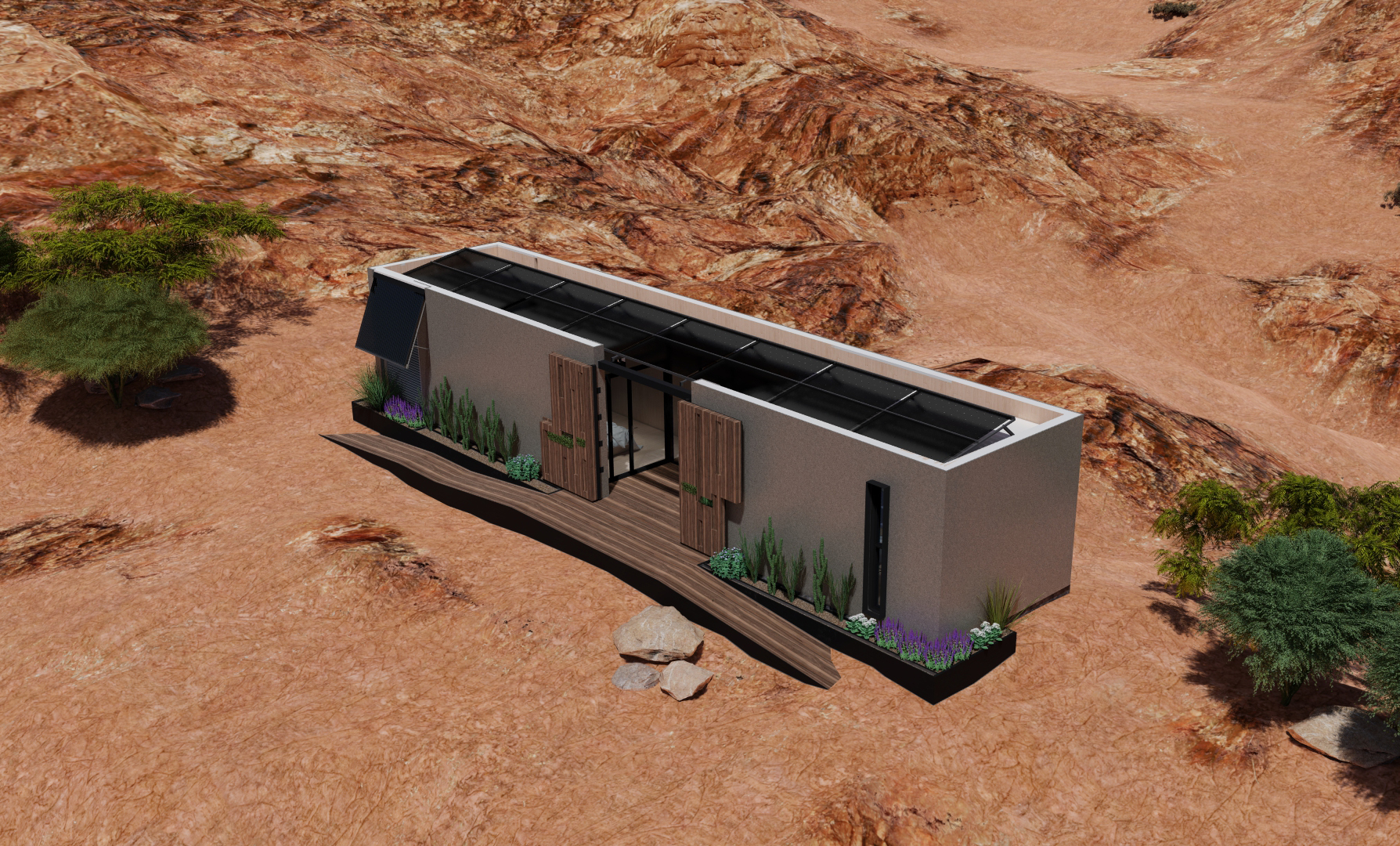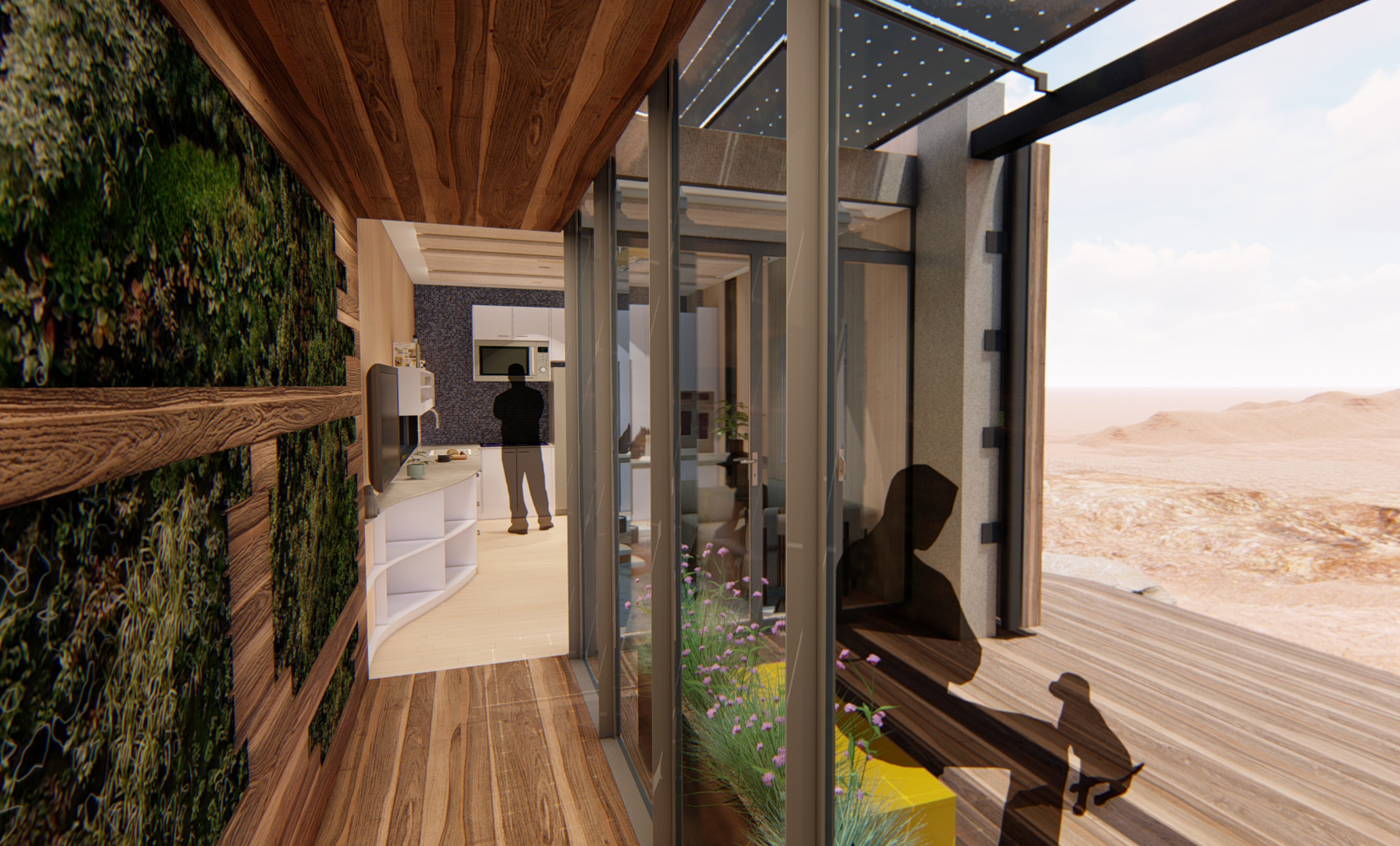Mojave Bloom: A Therapeutic Home for Post-Traumatic Healing
Tuesday, December 22, 2020
Architects are really good at a lot of things, but one quality in particular stands out to Eric Weber, an Associate Professor of Architecture at the University of Nevada Las Vegas (UNLV). He believes that once architects understand the nature of a challenge, they excel at developing thoughtful responses to it. Maybe that is why Weber’s Design + Build students chose to create a home that supports veterans dealing with post-traumatic stress disorder (PTSD) for their U.S. Department of Energy Solar Decathlon® 2020 Build Challenge entry, Mojave Bloom.
Team Las Vegas includes four veterans, one service member’s spouse, and Weber himself who is a Desert Storm veteran of the U.S. Marine Corps. Furthermore, Las Vegas is home to many former service members due to its proximity to Nellis Air Force Base and the U.S. Air Force Warfare Center. The mission of finding solutions for the challenges that returning soldiers face not only hit close to home, but really resonated with the team.

The UNLV students on Team Las Vegas developed the Mojave Bloom concept as a
sustainable salute to military veterans.
“We started with about 30 different ideas, then narrowed down to 15, then settled on our top three, which were very different concepts,” said Ryan Manthei, the student team leader and Weber’s graduate assistant. “After the final presentations, it was clear we wanted to create a house inspired by traditional desert architecture, but with a PTSD focus.”
One of the students on Team Las Vegas from Syria mentioned how traditional Islamic architecture often incorporates a central courtyard, or sahn. The sahn offers a secure and private outdoor setting within a building, providing a model of alfresco living that is shielded from the heat and noise of the outside world. Traditional southwestern architecture also incorporates courtyards into buildings, a practice the region borrowed from Spanish and Mexican prototypes.
“When we realized that there was precedent for desert typology and it worked for our target client, it checked all the boxes,” said Manthei.

Mojave Bloom creates an oasis from the bustling downtown of
Las Vegas and the Mojave Desert’s harsh environment.
Merging Environmental Engineering with Architectural Psychology
Source: https://www.nimh.nih.gov/health/topics/post-traumatic-stress-disorder-ptsd/index.shtml |
Students who compete in the Solar Decathlon must thoughtfully consider ways to achieve a high-performance home that is energy efficient enough to operate seamlessly using only renewable energy. Team Las Vegas’s approach combines the sustainability requirements of the competition with best practices from environmental engineering, behavioral health, and architectural psychology to meet their client’s specific needs.
The resulting house showcases the best of both worlds. For example, the interior courtyard is covered by a canopy of bifacial photovoltaic panels. This solar array choice not only provides energy for the home, but also offers the resident natural diffused light and shade from the desert sun. The courtyard is surrounded by operable window walls that allow the resident to increase or decrease airflow as needed, while also giving them the ability to observe their surroundings or take refuge when desired.
“The home acts to empower the user,” said Weber. “The ability to physically manipulate your environment is important psychologically for people who experience PTSD.”
- About 7% to 8% of the U.S. population will have PTSD at some point in their lives.
- Between 11% and 20% of veterans who served in Operation Iraqi Freedom, Enduring Freedom, or the Gulf War experience PTSD in a given year.
- About 30% of Vietnam veterans have had PTSD in their lifetime.

Designed to be a place of healing for veterans suffering the effects of wartime trauma,
the home connects the resident to their environment through a carefully orchestrated procession of sensory experiences.
A range of other features simultaneously supports sustainability and healing for the occupant. Living green walls cool the dry desert air via evaporative transpiration. This hydroponic system has the added benefit of providing the meditative sound of trickling water as it circulates through the space. Tectum panels in the ceiling have acoustic insulation, courtesy of recycled denim. This choice not only has multiple environmental benefits, but also serves as an acoustic absorber that reduces echoes and loud noises, which are common triggers. These features represent just a few examples of the many ways Mojave Bloom is as sustainable as it is soothing.
“If you’re doing good architecture, it’s going to be sustainable,” said Manthei. “We didn’t want to make a green building that wasn’t livable for a certain demographic, so we kept going back to the thought, ‘Does it fill the client’s requirements?’ The result is a space that’s well thought out beyond sustainable architecture—it’s holistic.”
Helping Each Other Heal
Once construction is complete, Mojave Bloom will compete remotely in the Solar Decathlon Build Challenge. The house will then travel across town to its final destination—the Las Vegas Healing Garden. This site is dedicated to memorializing the 58 victims of the October 1, 2017, mass shooting in Las Vegas.
Weber understands the value that comes with ensuring the students’ hard work has an enduring legacy. He helped permanently site UNLV’s Solar Decathlon 2013 house, Desert Sol, at the Las Vegas Springs Preserve where the visiting public can see the team’s innovations and strategies first-hand.
“If I could give anyone advice for this competition, it would be to make sure the afterlife is in mind from the beginning,” said Weber. “The city has been a great partner for us. We are in the final phase of interior detailing, and they have already prepped the site with utility connections.”
In the end, Mojave Bloom is destined to support the mission of the Healing Garden: helping each other heal.
“It’s not going to be used as a house, but it still fits with our overall intention,” said Manthei. “You don’t see much mental-health-centered design on display, which is a missed opportunity. Now there will be a long-term, larger connection to our concept because PTSD happens to other people besides veterans. For our architecture to be part of a larger community recovery effort, that’s powerful.”
